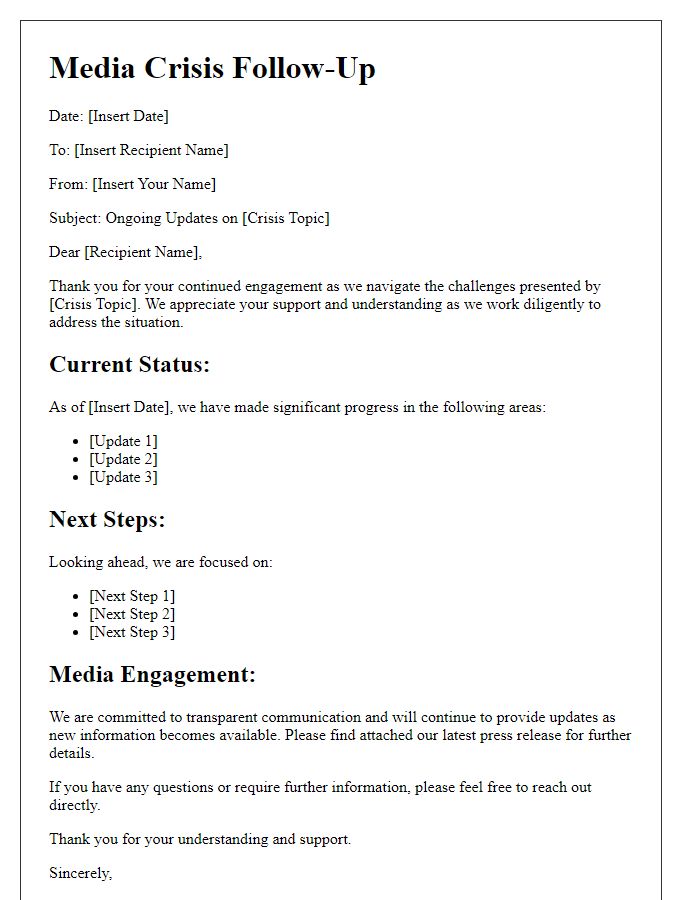In today's fast-paced digital world, the importance of effective media crisis communication cannot be overstated. Companies often find themselves under scrutiny when unexpected challenges arise, making a well-crafted response crucial. This letter template is designed to guide you through the essentials of communicating with the media during a crisis while maintaining transparency and trust with your audience. Dive in to discover how to manage your messaging and navigate turbulent times seamlessly!

Clarity and transparency in messaging.
In times of media crisis, clarity and transparency in messaging are paramount for maintaining public trust, particularly for organizations like corporations or government entities. Clear messaging should be defined by straightforward language, avoiding jargon to ensure broad understanding among diverse audiences. The importance of timely communication cannot be overstated; delayed responses can exacerbate negative perceptions, as seen in high-profile cases like the 2010 BP oil spill, where delayed public responses led to escalating scrutiny and diminished reputation. Transparency involves openly sharing information, including acknowledging mistakes and outlining corrective actions, fostering a sense of accountability. Establishing designated spokespersons can streamline communication efforts, ensuring consistent messaging across various platforms, such as social media channels and press releases. In crisis situations, leveraging multiple formats--written statements, video briefings, and FAQs--can accommodate different audience preferences, reinforcing the commitment to transparency.
Acknowledgment of the situation.
A media crisis can significantly impact an organization's reputation. Prompt acknowledgment of the situation is crucial in maintaining trust and transparency. Public statements must affirm the organization's awareness of the crisis, detailing the specific incident that triggered public concern. For instance, a recent incident involving product safety (e.g., the recall of a contaminated food item from a major brand) should be clearly stated, including the date and nature of the issue. Thorough communication about how the organization is assessing the situation, engaging with affected parties, and implementing corrective measures can mitigate damage and foster public confidence. Highlighting the commitment to ongoing updates and open lines of communication will further ensure that stakeholders feel informed and valued during the crisis.
Clear action plan and next steps.
In a media crisis communication scenario, crafting a clear action plan is paramount. First, establish a dedicated response team consisting of communication experts, legal advisors, and senior management members to ensure a comprehensive approach. Conduct an initial assessment within 24 hours to gather accurate information about the incident, determining the impact on stakeholders and the organization. Develop key messages that address the issue, highlight corrective measures, and affirm commitment to transparency. Schedule press releases and media briefings (aim for specific times, such as 10 AM and 3 PM) to provide timely updates, ensuring consistent messaging across all channels. Monitor media coverage and social media platforms for public sentiment, engaging with stakeholders directly when necessary to dispel misinformation. Finally, create a post-crisis evaluation report that analyzes the response effectiveness and outlines lessons learned, setting the stage for improved future crisis management strategies.
Contact information for media inquiries.
In crisis communication management, providing clear contact information is essential for media inquiries to ensure prompt responses. Designate a specific spokesperson, such as the Public Relations Manager, ensuring they have expertise in handling media relations. Include a direct phone number, like (555) 123-4567, enabling immediate communication. Provide a dedicated email address, for example, press@companyname.com, facilitating written inquiries. Specify business hours, typically 9 AM to 5 PM, Monday through Friday, allowing media personnel to know the best times to reach out. Ensure the spokesperson is knowledgeable about the company's stance and prepared to provide accurate, timely information.
Assurance and commitment to resolution.
In the wake of a recent incident involving data security breaches at TechCorp, our commitment to transparency remains unwavering. With over 5 million affected accounts, we prioritize the confidentiality of customer information stored on our servers, located in Austin, Texas. Immediate investigation efforts are underway with industry-leading cybersecurity experts from SecureNet Solutions engaged to assess the breach's impact. Customer trust is paramount; thus, we pledge to implement robust security protocols, including multi-factor authentication for user accounts. Our dedicated 24/7 helpline, at (800) 123-4567, is available for customer inquiries and concerns regarding this situation. We are also providing regular updates via our official website and social media channels, ensuring that our stakeholders are informed at every step of the resolution process.













Comments